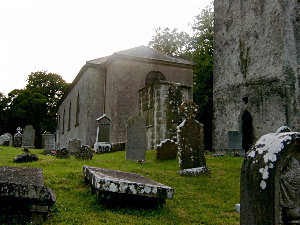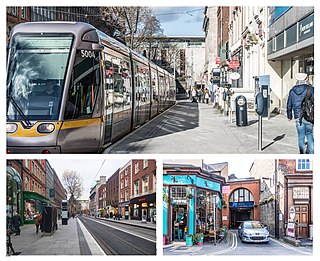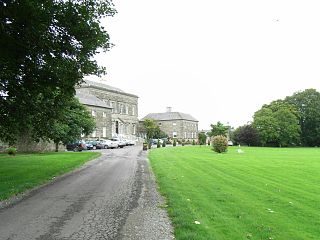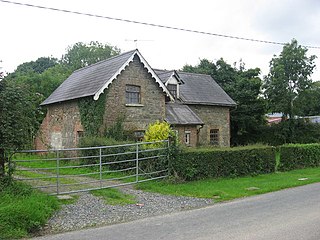
Ardbraccan is an ancient place of Christian worship in County Meath, Ireland. It is the location of the former residence of the Roman Catholic, then, after the Reformation, the Church of Ireland Bishop of Meath. It is approximately 30 miles from Dublin.
Bohermeen is a Roman Catholic parish in the Irish Diocese of Meath. Its English name is a corruption of an ancient Irish language name, An Bóthar Mín, which meant the smooth road. Originally one of the five famed ancient roadways that led from the mediaeval capital of Ireland, Tara, approximately 10 miles away cut through the area. The quality of the roadway, in an era of dirt-roads, earned for it the nickname of the smooth road, An Bóthar Mín.

Castlepollard is a village in north County Westmeath, Republic of Ireland. It lies west of Lough Lene and northeast of Lough Derravaragh and Mullingar.

Castleblayney is a town in County Monaghan, Ireland. The town had a population of 3,607 as of the 2016 census. Castleblayney is near the border with County Armagh in Northern Ireland, and lies on the N2 road from Dublin to Derry and Letterkenny.
Allenstown House was a large five-bay, four-story Georgian mansion in County Meath, Ireland. It was built in around 1750 by William Waller.

Dawson Street is a street on the southern side of central Dublin, running from St Stephen's Green to the walls of Trinity College Dublin. It is the site of the residence of the Lord Mayor of Dublin, the Mansion House.

Dunsany Castle, Dunsany, County Meath, Ireland is a modernised Anglo-Norman castle, started c. 1180 / 1181 by Hugh de Lacy, who also commissioned the original Killeen Castle, nearby, and the famous Trim Castle. It is one of Ireland's oldest homes in continuous occupation, possibly the longest occupied by a single family, having been held by the Cusack family and their descendants by marriage, the Plunketts, from foundation to the present day. The castle is surrounded by its demesne, the inner part of the formerly extensive Dunsany estate. The demesne holds a historic church, a walled garden, a stone farm complex, and an ice house, among other features, and is home to a wide range of fauna.

Agher is a crossroads and townland in County Meath, Ireland. It is located 3 km (1.9 mi) southwest of Summerhill.

Summerhill is a heritage village in County Meath, Ireland. It is located in the south of the county, between Trim and Kilcock on the R158 and west of Dunboyne on the R156. It is the site of one of the most important battles in 17th century Ireland, the Battle of Dungan's Hill. Up until 1667, the village was known in English as 'The Knock' or 'Lynchs' Knock' as it was the ancestral home of the Norman-Irish Lynch family, whence came the Galway merchant family of the same name - one of the "Tribes of Galway". However, in about 1667, it was renamed Summerhill by the Langfords, the landed gentry, builders of Summerhill House and planners of the village as it is today. The ruins of the large Lynch castle can be seen in the village today while, apart from the village layout, only the demesne walls and entrance pillars of Summerhill House still stand.

Bellinter House is a large classic country house of Georgian heritage, recently renovated and opened as a 34-room luxury spa hotel. It is in 12 acres of parkland beside the River Boyne in County Meath, Ireland some 10 km from Navan. Bellinter takes its name from the Irish Baile an tSaoir, which means the home of the carpenter.

Downhill House was a mansion built in the late 18th century for Frederick, 4th Earl of Bristol and Lord Bishop of Derry, at Downhill, County Londonderry. Much of the building was destroyed by fire in 1851 before being rebuilt in the 1870s. It fell into disrepair after the Second World War.

Durhamstown, known less frequently as Dormstown, is a townland outside Navan in County Meath, Ireland. In religious terms it is covered by the Roman Catholic parish of Bohermeen. Durhamstown townland lies in the civil parish of Ardbraccan, and has an area of 1,025 acres (1.602 sq mi).

Glenville is a village and townland in County Cork, Ireland. It is situated approximately 20 km northeast of Cork city. Glenville is part of the Cork North-Central.
Benjamin John Plunket was a 20th-century Anglican bishop in Ireland.

Drumcar House is a manor house in the historical parish of Drumcar in the barony of Ardee, 1 mile (1.6 km) northeast of Dunleer, County Louth, Leinster, Ireland. The house was built in 1777. It was home to the McClintock family from then to the 1940s, stemming from Alexander McClintock (1692–1775). One of its best known owners was John McClintock (1770–1855), a magistrate for County Louth, and formerly Serjeant at Arms in the Irish House of Commons, who was known to be occupying the estate in 1805 and until his death. The house was sold in about 1903 by The 2nd Baron Rathdonnell to his cousin, Frank McClintock (1853–1924), Rector of Drumcar and Dean of Armagh.

Drumcar is a village and a historical parish, in the barony of Ardee, County Louth, Leinster, northeastern Ireland.

Summerhill House was a 100-roomed mansion in County Meath, Ireland which was the ancestral seat of the Viscounts Langford and the Barons Langford. Built in 1731, Summerhill House demonstrated the power and wealth the Langford Rowley family had at the time. They owned vast amounts of land in counties Meath, Westmeath, Cork, Londonderry, Antrim, and Dublin as well as in Devon and Cornwall in the England.

The Archbishop's Palace, Armagh, Northern Ireland, is a landmark Neo-Classical building located on 300 acres of parkland just south of the centre of the city. The building served as primary residence of the Church of Ireland Archbishops of Armagh for over two hundred years, from 1770 to 1975, and thereafter as headquarters of Armagh City and District Council from then until April 2015 when that local authority was replaced following the reform of local government in Northern Ireland in that year.
Clonsilla or "Clonsillagh" is a civil parish and a townland located in the south-western corner of the modern county of Fingal, Ireland. The civil parish is part of the ancient barony of Castleknock. It is centred on the suburban village of Clonsilla. In geology, the parish rests on a substratum of limestone and comprises 2943 statute acres, the whole of which is arable land. It is roughly bounded to the north by the old "Navan Road" – the modern N3; to the east by the civil parish of Castleknock; to the south by the River Liffey; to the south-east by the civil parish of Leixlip, chiefly in County Kildare, and to the north-west by the civil parish of Dunboyne in County Meath.

















